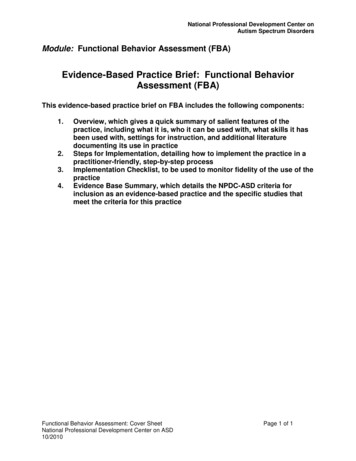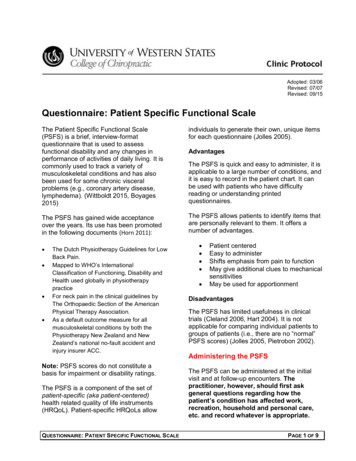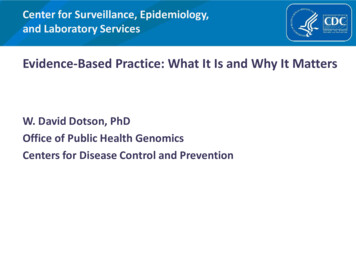
Transcription
National Professional Development Center onAutism Spectrum DisordersModule: Functional Behavior Assessment (FBA)Evidence-Based Practice Brief: Functional BehaviorAssessment (FBA)This evidence-based practice brief on FBA includes the following components:1.2.3.4.Overview, which gives a quick summary of salient features of thepractice, including what it is, who it can be used with, what skills it hasbeen used with, settings for instruction, and additional literaturedocumenting its use in practiceSteps for Implementation, detailing how to implement the practice in apractitioner-friendly, step-by-step processImplementation Checklist, to be used to monitor fidelity of the use of thepracticeEvidence Base Summary, which details the NPDC-ASD criteria forinclusion as an evidence-based practice and the specific studies thatmeet the criteria for this practiceFunctional Behavior Assessment: Cover SheetNational Professional Development Center on ASD10/2010Page 1 of 1
National Professional Development Center onAutism Spectrum DisordersModule: Functional Behavior Assessment (FBA)Overview of Functional Behavior AssessmentCollet-Klingenberg, L. (2008). Overview of functional behavior assessment. Madison, WI: TheNational Professional Development Center on Autism Spectrum Disorders, WaismanCenter, The University of Wisconsin.Functional behavior assessment (FBA) is a systematic set of strategies that is used todetermine the underlying function or purpose of a behavior, so that an effective intervention plancan be developed. FBA consists of describing the interfering or problem behavior, identifyingantecedent or consequent events that control the behavior, developing a hypothesis of thebehavior, and testing the hypothesis. Data collection is an important part of the FBA process.Often, teachers/practitioners use functional communication training (FCT), differentialreinforcement, response interruption/redirection, extinction, and stimulus control/environmentalmodification to address these behaviors in learners with ASD.EvidenceFBA meets evidence-based criteria with five single-subject and one group design studies acrossages, as well as in the domains of behavior and communication.With what ages is FBA effective?According to the evidence-based studies, learners with ASD ranged in age from 3 to 15 yearswith the majority of studies showing the effectiveness of functional behavior assessment withelementary age learners.What skills or intervention goals can be addressed by FBA?FBA targets skills in the domains of behavior and communication, usually with a focus ofdecreasing inappropriate behavior and teaching or increasing appropriate communicativealternatives. The studies in the evidence base targeted behaviors described as severe,stereotypical, disruptive, escape-motivated, rejecting, and leading. Replacement skills includedmore appropriate forms of communication such as signing, pointing, talking, and the use ofalternative and augmentative communication (AAC) devices.In what settings can FBA be effectively used?In the evidence base, functional behavior assessment procedures were implemented in avariety of home, school, and community settings.Evidence BaseThe studies cited in this section document that this practice meets the NPDC on ASD’s criteriafor an evidence-based practice. This list is not exhaustive; other quality studies may exist thatwere not included.Functional Behavior Assessment: OverviewNational Professional Development Center on ASD10/2010Page 1 of 3
National Professional Development Center onAutism Spectrum DisordersModule: Functional Behavior Assessment (FBA)PreschoolMancil, G.R., Conroy, M.A., Nakao, T., & Alter, P.J. (2006). Functional communication trainingin the natural environment: A pilot investigation with a young child with autism spectrumdisorder. Education and Treatment of Children, 29(4), 615-633.ElementaryBuckley, S., & Newchok, D. (2005). Differential impact of response effort within a responsechain on use of mands in a student with autism. Research in Developmental Disabilities,26(1), 77-85.LaBelle, C., & Charlop-Christy, M. (2002). Individualizing functional analysis to assess multipleand changing functions of severe behavior problems in children with autism. Journal ofPositive Behavior Interventions, 4(4), 231-241.Lucyshyn J. M., Albin, R. W., Horner, R. H., Mann, J. C., Mann, J. A., & Wadsworth, G. (2007).Family implementation of positive behavior support for a child with autism: Longitudinal,single-case, experimental, and descriptive replication and extension. Journal of PositiveBehavior Interventions, 9(3), 131-150.Middle/High SchoolButler, L. R., & Luiselli, J. K. (2007). Escape-maintained problem behavior in a child with autism:Antecedent functional analysis and intervention evaluation of non-contingent escape andinstructional fading. Journal of Positive Behavior Interventions, 9(4), 195-202.Selected Additional ReferencesAsmus, J. M., Franzese, J. C., Conroy, M. A., & Dozier, C. L. (2003). Clarifying functionalanalysis outcomes for disruptive behaviors by controlling consequence delivery forstereotypy. School Psychology Review, 32(4), 624-630.Aspy, R., & Grossman, B. G. (2007). The ziggurat model. Shawnee Mission, KS: AutismAsperger Publishing Company.Bregman, J. D., Zager, D., & Gerdtz, J. (2005). Behavioral interventions. In F. R. Volkmar, R.Paul, A. Klin, & D. Cohen (Eds.), Handbook of autism and pervasive developmentaldisorder, 3rd ed. (pp. 897-924). Hoboken, NJ: John Wiley & Sons.Carr, E. G., Horner, R. H., Turnbull, A. P., Marquis, J. G., McLaughlin, D. M., McAtee, M. L., etal., (1999). Positive behavior support for people with developmental disabilities: Aresearch synthesis. Washington, DC: American Association on Mental Retardation.Functional Behavior Assessment: OverviewNational Professional Development Center on ASD10/2010Page 2 of 3
National Professional Development Center onAutism Spectrum DisordersModule: Functional Behavior Assessment (FBA)Drasgow, E., Halle, J. W., Ostrosky, M. M., & Harbers, H. M. (1996). Using behavior indicationand functional communication training to establish an initial sign repertoire with a youngchild with severe disabilities. Topics in Early Childhood Special Education, 16, 500-521.Fox, L., Dunlap, G., & Buschbacher, P. (2000). Understanding and intervening with children’sinterfering behavior: A comprehensive approach. In A. M. Wetherby & B. M. Prizant(Eds.), Autism spectrum disorders: A transactional developmental perspective, Volume 9(pp. 307-332). Baltimore: Brookes Publishing Company.Henry, S., & Myles, B. S. (2007). The comprehensive autism planning system (CAPS) forindividuals with Asperger’s syndrome, autism, and related disabilities: Integrating bestpractices throughout the student’s day. Shawnee Mission, KS: Autism AspergerPublishing Company.Koegel, L. K., Stiebel, D., & Koegel, R. L. (1998). Reducing aggression in children with autismtoward infant or toddler siblings. The Journal of Association for Persons with SevereHandicaps, 23(2), 111-118.Martin, C. A., Drasgow, E., Halle, J. W., & Brucker, J. M. (2005). Teaching a child with autismand severe language delays to reject: Direct and indirect effects of functionalcommunication training. Educational Psychology, 25(2&3), 287-304.National Technical Assistance Center on Positive Behavioral Interventions and Supports.http://www.pbis.orgO’Neill, R. E., & Sweetland-Baker, M. (2001). Brief report: An assessment of stimulusgeneralization and contingency effects in functional communication training with twostudents with autism. Journal of Autism and Developmental Disorders, 31(2), 235-240.Functional Behavior Assessment: OverviewNational Professional Development Center on ASD10/2010Page 3 of 3
National Professional Development Center onAutism Spectrum DisordersModule: Functional Behavior Assessment (FBA)Evidence Base for Functional Behavior AssessmentThe National Professional Development Center on ASD has adopted the following definition ofevidence-based practices.To be considered an evidence-based practice for individuals with ASD, efficacy must beestablished through peer-reviewed research in scientific journals using:randomized or quasi-experimental design studies. Two high quality experimental orquasi-experimental group design studies,single-subject design studies. Three different investigators or research groups musthave conducted five high quality single subject design studies, orcombination of evidence. One high quality randomized or quasi-experimental groupdesign study and three high quality single subject design studies conducted by atleast three different investigators or research groups (across the group and singlesubject design studies).High quality randomized or quasi experimental design studies do not have critical design flawsthat create confounds to the studies, and design features allow readers/consumers to rule outcompeting hypotheses for study findings. High quality in single subject design studies isreflected by a) the absence of critical design flaws that create confounds and b) thedemonstration of experimental control at least three times in each study.This definition and criteria are based on the following sources:Horner, R., Carr, E., Halle, J., McGee, G., Odom, S., & Wolery, M. (2005). The use of singlesubject research to identify evidence-based practice in special education. ExceptionalChildren, 71, 165-180.Nathan, P., & Gorman, J. M. (2002). A guide to treatments that work. NY: Oxford UniversityPress.Odom, S. L., Brantlinger, E., Gersten, R., Horner, R. D., Thompson, B., & Harris, K. (2004).Quality indicators for research in special education and guidelines for evidence-basedpractices: Executive summary. Arlington, VA: Council for Exceptional Children Divisionfor Research.Rogers, S. J., & Vismara, L. A. (2008). Evidence-based comprehensive treatments for earlyautism. Journal of Clinical Child and Adolescent Psychology, 37(1), 8-38.Functional Behavior Assessment: Evidence BaseNational Professional Development Center on ASD10/2010Page 1 of 2
National Professional Development Center onAutism Spectrum DisordersModule: Functional Behavior Assessment (FBA)Using these criteria, the empirical studies referenced below provide documentation forsupporting functional behavior assessment as an evidence-based practice for children withASD. This list is not exhaustive; other quality studies may exist that were not included.PreschoolMancil, G.R., Conroy, M.A., Nakao, T., & Alter, P.J. (2006). Functional communication trainingin the natural environment: A pilot investigation with a young child with autism spectrumdisorder. Education and Treatment of Children, 29(4), 615-633.ElementaryBuckley, S., & Newchok, D. (2005). Differential impact of response effort within a responsechain on use of mands in a student with autism. Research in Developmental Disabilities,26(1), 77-85.LaBelle, C., & Charlop-Christy, M. (2002). Individualizing functional analysis to assess multipleand changing functions of severe behavior problems in children with autism. Journal ofPositive Behavior Interventions, 4(4), 231-241.Lucyshyn J. M., Albin, R. W., Horner, R. H., Mann, J. C., Mann, J. A., & Wadsworth, G. (2007).Family implementation of positive behavior support for a child with autism: Longitudinal,single-case, experimental, and descriptive replication and extension. Journal of PositiveBehavior Interventions, 9(3), 131-150.Middle/High SchoolButler, L. R., & Luiselli, J. K. (2007). Escape-maintained problem behavior in a child with autism:Antecedent functional analysis and intervention evaluation of non-contingent escape andinstructional fading. Journal of Positive Behavior Interventions, 9(4), 195-202.Functional Behavior Assessment: Evidence BaseNational Professional Development Center on ASD10/2010Page 2 of 2
National Professional Development Center onAutism Spectrum DisordersModule: Functional Behavior AssessmentSteps for Implementation: Functional Behavior AssessmentNeitzel, J. & Bogin, J. (2008). Steps for implementation: Functional behavior assessment.Chapel Hill, NC: The National Professional Development Center on Autism SpectrumDisorders, Frank Porter Graham Child Development Institute, The University of NorthCarolina.Teachers/practitioners often conduct a functional behavior assessment as a first step in trying tounderstand why a learner with ASD may be engaging in interfering behaviors. As the function ofthe behavior becomes apparent, teachers/practitioners develop interventions to reduce theoccurrence of the interfering behavior in question. Often, teachers/practitioners use functionalcommunication training (FCT), differential reinforcement, response interruption/redirection,extinction, and stimulus control/environmental modification to address these behaviors inlearners with ASD. When developing intervention plans, teachers/practitioners should refer tothe specific briefs for these practices to access the steps for implementation as well as theimplementation checklists.When planning for and implementing a functional behavior assessment (FBA) with children andyouth with ASD, the following steps are recommended.Step 1. Establishing a TeamIn Step 1, a multidisciplinary team is established to provide a variety of perspectives about theinterfering behavior that a particular learner with ASD is exhibiting. Members of the team shouldinclude all individuals who have observed the interfering behavior demonstrated by the learnerwith ASD over an extended period of time in a variety of settings and conditions.1. A multidisciplinary team is formed that includes:a. the learner’s teachers: special education, general education (if the learner spendsany part of the day in an inclusive setting). The teachers who are members of theteam should be from classes where the interfering behavior occurs.b. any related service personnel: speech-language pathologist, occupational therapist,behavioral therapist, psychologist, etc. These individuals should be included if theyhave regular involvement with the learner with ASD.c. paraprofessional(s) that work directly with the learner with ASD. These individualsoften have extended interactions with learners with ASD and may spend the mosttime with them on a daily basis.d. the learner’s parents. Parents should be included because they are mostknowledgeable about their child’s behavior across settings and situations.Functional Behavior Assessment: Steps for ImplementationNational Professional Development Center on ASD10/2010Page 1 of 12
National Professional Development Center onAutism Spectrum DisordersModule: Functional Behavior Assessmente. the learner with ASD (if developmentally appropriate). Learners with ASD mayprovide valuable information about their behaviors, perceptions, and reasons why aparticular behavior may be occurring.2. Team members identify one person to be the FBA coordinator.Team members decide who will be the team coordinator during the FBA process. This personcoordinates and manages data collection efforts, answers questions from and stays in touchwith other team members, and ensures that the FBA is being implemented as intended.Possible team members who might assume this role include an autism services coordinator,special educator, speech-language pathologist, or occupational therapist. The FBA coordinatorshould have training and experience in conducting FBAs.Step 2. Identifying the Interfering BehaviorIn Step 2, members of the multidisciplinary team identify the interfering behavior that will serveas the target of the assessment and intervention strategies. Interfering behaviors includedisruptive or repetitive behaviors that interfere with optimal development, learning, and/orachievement.1. Team members identify the interfering behavior that is most problematic for the learnerthat will serve as the focus of the FBA.If more than one interfering behavior is occurring on a regular basis, team members mustdecide which behavior will serve as the target for the FBA. Any behaviors that involve safetyshould be addressed first. The following questions also may be helpful when deciding whichbehavior should be the target for intervention:Is the behavior dangerous to the learner or others?Does the behavior interfere with learning (e.g., academic, social)?Does the behavior interfere with socialization or acceptance from peers?Is the behavior disruptive or intense on a frequent basis?2. After identifying the interfering behavior, the team determines:a. how long the behavior has been interfering with the learner’s development andlearning.b. if the behavior involves aggression or damage to property.c. if the behavior might be the result of environmental factors (e.g., lighting, noise level).For example, what is unique about the environment(s) where the behavior does notoccur? What is unique about the environment where the behavior does occur? Doesthe behavior occur more often under a specific set of circumstances (e.g., duringtransitions, in the hallway)?Functional Behavior Assessment: Steps for ImplementationNational Professional Development Center on ASD10/2010Page 2 of 12
National Professional Development Center onAutism Spectrum DisordersModule: Functional Behavior Assessmentd. if the interfering behavior might occur because learners are being asked todemonstrate a skill that they cannot perform (e.g., language/ communication, social).For example, does the learner not know how to use skills needed in a particularsetting or activity? Or is the learner able to use needed skills, but not consistently?e. when and where the behavior is occurring. For example, what is different about theenvironment(s) where the behavior does occur (e.g., number of other students at theactivity, time of day)?f.other behaviors the learner exhibits immediately before the behavior occurs(antecedents).g. what happens immediately after the interfering behavior occurs (consequences).Step 3. Collecting Baseline DataStep 3 focuses on collecting data from multiple sources to better understand the interferingbehavior prior to designing and implementing an intervention strategy. Although collectingbaseline data is an essential feature of FBA, data collection is important throughout the FBAprocess because it helps teachers/practitioners define the behavior, record what the learner iscurrently doing, and evaluate the outcomes of the intervention plan.1. Prior to designing and implementing an intervention, teachers/practitioners use indirectassessment methods that include:a. reviewing previous and current records. The purpose of record review is to gaininsight into the learner’s current behavior by looking at previous reports orassessments that might include: medical reports, psychological evaluations, speechand/or occupational therapy assessments, educational testing, IEP/IFSP, incidentreports/disciplinary action reports, and anecdotal reports.b. conducting formal and informal interviews with school staff, family members, and thelearner with ASD (if appropriate). Team members, particularly the FBA coordinator,conduct both informal and formal interviews to gather information about the behaviorfrom multiple perspectives. At least one of the following tools is used during thisprocess:The Functional Assessment Screening Tool (FAST; Iwata & deLeon, 1995).This tool is used to determine the potential causes of the behavior. With theFAST, raters are asked to answer 18 yes/no questions. Scores are added up andplaced into four likely categories of function ranging from social reinforcement(attention) to automatic reinforcement (pain attenuation).Problem Behavior Questionnaire (PBQ; Lewis, Scott, & Sugai, 1994). Thisquestionnaire is used to determine the potential function of the behavior (e.g.,access to peer attention, access to teacher attention, setting events). With theFunctional Behavior Assessment: Steps for ImplementationNational Professional Development Center on ASD10/2010Page 3 of 12
National Professional Development Center onAutism Spectrum DisordersModule: Functional Behavior AssessmentPBQ, raters answer 15 items and indicate the frequency with which the behavioris observed.Questions about Behavioral Function in Mental Illness (QABF-MI; Singh etal., 2006). This questionnaire helps raters determine the potential function of thebehavior (attention, escape, non-social, physical, tangible). With the QABF-MI,raters answer how often the behavior occurs.Functional Assessment Interview (FAI; O’Neill et al., 1997). Thisquestionnaire can be used to interview teachers, parents, and otherschool/community staff. The FAI takes approximately 45-90 minutes toadminister and provides the following outcomes: description of the interferingbehavior, events or factors that predict the behavior, possible function of thebehavior, and summary statements (behavior hypothesis).Student-Directed Functional Assessment Interview (Student-FAI; O’Neill etal., 1997). This interview is used with learners with ASD who can reliably reporton their behavior. It takes approximately 20-40 minutes to conduct an interviewby a member of the team who has no negative history with the learner.The next step in the process is to collect observation-based data on the occurrence of theinterfering behavior. Prior to collecting baseline data, however, teachers/practitioners clearlydefine the interfering behavior so that it can be observed easily.2. Team members clearly describe the interfering behavior and identify data collectionmeasures that will be used to assess the interfering behavior prior to designing andimplementing an intervention.During this step, it is critical that all team members agree on definitions of the behavior and thedata collection measures that will be used during the baseline data collection phase of the FBA(i.e., data collected before the intervention is designed and implemented). For example, if thebehavior is “John talks during English class,” the team needs to come to a consensus aboutwhat “talks during English class” means. Does it mean any talking? What if John talks quietlyduring class? By clearly identifying the behavior, team members will be able to collect baselinedata that are accurate and reliable.Example: John talks loudly during English class when the teacher is instructing the entire class.This behavior involves several aspects – how often he talks during instruction, how loudly hetalks during instruction, and perhaps how long his statements are (duration).Baseline data on the interfering behavior are gathered in locations and at times when thebehavior appears to occur most often; however, it also is sampled in other locations or at othertimes. Determining both when and where the behavior occurs as well as when and where itdoes not occur will help teachers/practitioners focus the assessment on what happens beforeand after the behavior. For example, a team might determine that John talks so loudly duringFunctional Behavior Assessment: Steps for ImplementationNational Professional Development Center on ASD10/2010Page 4 of 12
National Professional Development Center onAutism Spectrum DisordersModule: Functional Behavior AssessmentEnglish class that the teacher is unable to instruct the rest of the class. As a result, the Englishteacher and other relevant team members should focus their data collection efforts on thisbehavior during this particular class to determine its potential causes.3. Team members determine how long baseline data should be collected and who willcollect it.During the baseline phase, it is important to collect data for a sufficient period of time to identifyconsistencies in the behavior. Team members should decide how long data will be collected(e.g., several 15 minute periods per day for three days, one week, two weeks), and what willhappen if an insufficient/inadequate amount of data are collected during baseline (e.g., redesignthe data collection method, observe at a different time).Team members also must decide who will collect the initial baseline data. For example, it mightbe easiest for a paraprofessional to collect data across the day. The team also may decide thatit would be easier to have an objective observer collect data rather than the classroom teacherwho is teaching lessons. Team members also should consider family involvement. For instance,is it possible for family members to collect data at home and in the community? These data willbe particularly useful if the behavior is occurring in these settings as well. The decision aboutwho will collect data should be individualized and based on the needs and resources of eachteam. If more than one team member collects data, they should observe at the same time to besure that they are coding the behavior in the same way.4. Teachers/practitioners use direct observation methods that generally include:a. using A-B-C data charts. A-B-C data charts help team members determine whathappens right before the behavior (the antecedent), the behavior that occurs, andwhat happens directly after the behavior (the consequence). These data provideinsight into why the learner may be engaging in a particular behavior. The followingis an example of an A-B-C data collection chart.A (Antecedent) (describe theactivity and specific eventspreceding the behavior)Joe was told to line up formath class.Joe was told to line up forlunch.B (Behavior) (describeexactly what the behaviorlooked like)Joe hit a peer in line.Joe pulled a peer’s hair.C (Consequence) (describeevents that followed or resultsof the behavior)Joe was moved to the end ofthe line.Joe was moved to the end ofthe line.b. using scatterplots. Scatterplots help team members determine:the possible functions of the behavior.when the behavior is occurring.times of the day when an intervention might be implemented to reduce theinterfering behavior.Functional Behavior Assessment: Steps for ImplementationNational Professional Development Center on ASD10/2010Page 5 of 12
National Professional Development Center onAutism Spectrum DisordersModule: Functional Behavior AssessmentThe following example illustrates how a scatterplot can be used during the FBA to identify whenand where the behavior is occurring. The gray boxes marked with “Xs” indicate that the behavioroccurred at that particular time on a particular g (independent work)Reading (small group)Science (whole group)LunchRecess1:00Math (whole group)8/238/24XDate8/25 8/26XXXXX8/278/28XXXXXXXXXXThe chart can then be used to identify patterns of behavior. For example, the above scatterplotindicates that this learner with ASD exhibits the interfering behavior most consistently duringrecess. Therefore, this might be a time when an intervention could be implemented to reducethe interfering behavior. It is important to note that scatterplots used in FBA are different fromthose used by researchers when conducting statistical analyses. FBA scatterplots are used toidentify patterns of behavior and are helpful in determining when interventions can beimplemented.c. using standardized behavior rating scales. These types of rating scales provide astandardized form to observe learner behavior. One example is the FunctionalAssessment Observation Form (FAO; O’Neill et al., 1997).d. conducting learner motivation assessments. These types of assessments help toidentify what motivates individual learners to engage in a particular behavior. Oneexample is the Motivation Assessment Scale (MAS; Durand & Crimmins, 1992). Withthis scale (http://www.monacoassociates.com/mas/MAS.html), raters are asked 16questions about the interfering behavior. Scores are added up and ranked bycategory of function (sensory, escape, attention, tangible).e. conducting learner reinforcer preference assessments. These types of assessmentshelp team members identify activities, materials, etc. that are motivating to thelearner and might be used during an intervention to decrease interfering behaviorsand increase more appropriate behaviors. This type of procedure usually takes aboutfive minutes and involves the steps listed below.Sit in front of the learner and hold up two items and say to the learner, "Pickone."Wait ten seconds for the learner to indicate his/her choice in whatever manner isappropriate to the learner (e.g., reaching, pointing, verbalizing, using a switch oraugmentative communication device).Place the selected and non-selected objects in their appropriate containers (i.e.,one to hold the learner’s selections, one to hold the materials not selected).Functional Behavior Assessment: Steps for ImplementationNational Professional Development Center on ASD10/2010Page 6 of 12
National Professional Development Center onAutism Spectrum DisordersModule: Functional Behavior AssessmentContinue the first three steps until half the objects presented are chosen (Mason& Egel, 1995).5. Teachers/practitioners use indirect and direct assessment results to identify:a. where the behavior is happening.b. with whom the behavior is occurring.c. when the behavior is happening.d. activities during which the behavior occurs.e. what other students are doing when the behavior starts.f.what teachers/adults are doing when the behavior starts.g. proximity of other students, teachers, and/or adults.h. the noise level in the environment.i.the number of individuals in the area.j.other environmental conditions (e.g., lighting, door open/closed).k. the function of the behavior. Behaviors fall into two categories of function:to get or obtain something desired: obtain internal stimulation (wanting somethingbecause it feels good), obtain attention, obtain activities or objects orto escape or avoid: internal stimulation (not wanting something because it feelsbad), escape or avoid attention, avoid tasks or activities.6. Teachers/practitioners identify other variables that might be influencing the interferingbehavior (e.g., medication, family/home variables
3. Implementation Checklist, to be used to monitor fidelity of the use of the practice 4. Evidence Base Summary, which details the NPDC-ASD criteria for . Functional behavior assessment (FBA) is a systematic set of strategies that is used to . behavior, and testing the hypothesis. Data collection is an important part of the FBA process .










